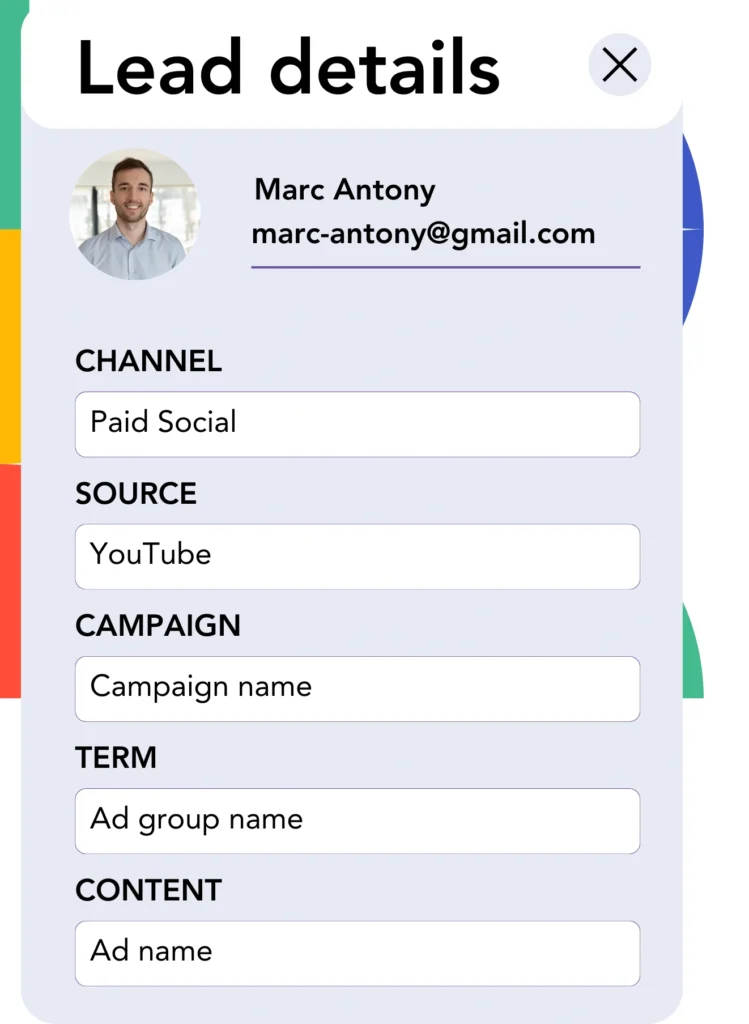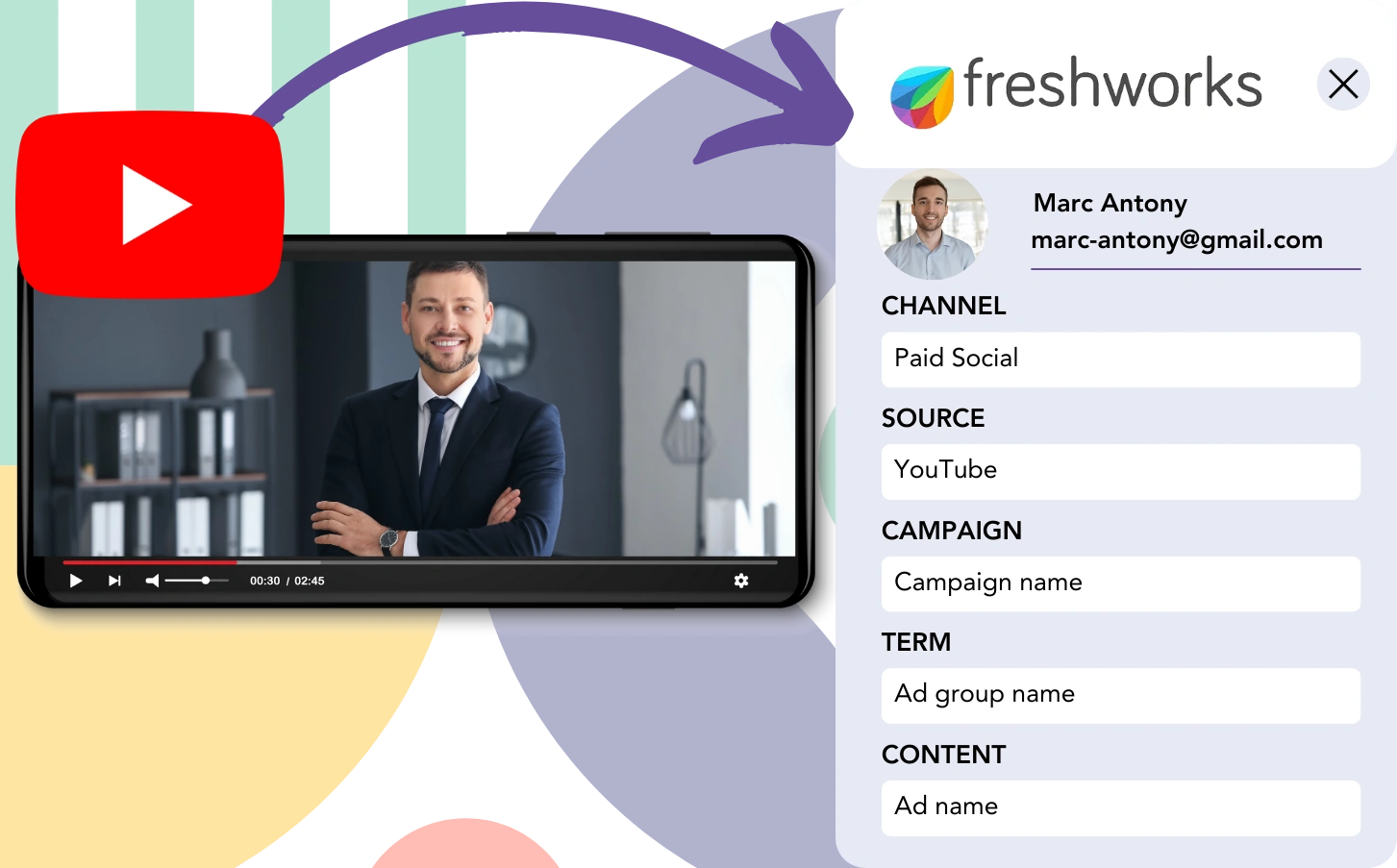Leads sourced from YouTube are directed into Freshworks CRM, but connecting them to a specific YouTube ads is not feasible. Even when these leads turn into customers, no link to the original YouTube ad can be established.
The lack of tracking restricts your ability to assess your YouTube ads performance, without providing clarity on which ads are driving leads and customers. Consequently, you allocate resources to ads without realizing their impact.
Luckily, an easy method allows you to link each lead to the exact YouTube campaign, ad group, and ad that brought it in.
Let’s proceed step by step!
How to Track YouTube Ads in Freshworks CRM
Step 1: Add Leadsources in the head tag of your website

Leadsources is a user-friendly tool for tracking lead sources. Place it on your website, and it will collect up to 7 data points on each lead.
➡️ Sign up to Leadsources.io for free
➡️ Add the Leadsources tracking code to your site
Step 2: Add the UTM parameters to your YouTube Ads

To gather data from YouTube ads, add UTM parameters to your ad URL for campaign, ad group, and ad tracking. Here’s a sample:
UTM_source=YouTubeUTM_campaign=campaign-nameUTM_term=ad-group-nameUTM_content=ad-name
The final link should be structured like this:
https://www.yourdomain.com/?&UTM_source=youtube&UTM_campaign=campaign-name&UTM_term=ad-group-name&UTM_content=ad-nameImportant to mention: Leadsources tracks lead source information, regardless of whether UTM parameters are present, ensuring thorough lead tracking.
Step 3: Add the hidden fields in your form

Form fields that are hidden from users can still hold valuable data that gets submitted with the form.
These hidden fields are used by Leadsources to store lead source data. When the lead submits the form, Leadsources automatically inputs YouTube Ads data.
Step 4: Capture the YouTube Ads data in Freshworks CRM

Leadsources fetches all relevant YouTube campaign, ad group, and ad data when users click your ads and visit your website.
Following this, Leadsources inserts the YouTube ad data into the hidden fields on your form.
Once the form is submitted, you will be able to see the YouTube ad data and lead details in Freshworks CRM (connecting the form to Freshworks CRM is necessary).
How does Leadsources work?
When someone lands on your website, Leadsources fetches YouTube ad data and populates it into the form’s hidden fields. After the form is submitted, the data, including the lead’s name and email, is forwarded to Freshworks CRM.
With Leadsources, you get detailed lead source information for every individual lead:
| Lead source data | Fetched automatically |
| Channel | ✅ |
| Source | ✅ |
| Campaign | ✅ OR use UTM_campaign |
| Content | UTM_content parameter is required |
| Term | UTM_term parameter is required |
| Landing page | ✅ |
| Landing page subfolder | ✅ |
As demonstrated in the table above, in cases where UTM parameters aren’t usable—like organic sources such as Google search or when your website is included in an article—Leadsources still records the following lead source data:
- Channel
- Source
- Campaign
- Landing page
- Landing page subfolder
Leadsources offers a unique advantage by tracking lead sources across every marketing channel, both paid and organic.
Performance reports: Lead, sales, and revenue by source
By capturing YouTube Ads data in Freshworks CRM, you gain the ability to generate performance reports such as:
- Leads, sales, and revenue by channel
- Leads, sales, and revenue by source
- Leads, sales, and revenue by campaign (aka. YouTube campaign)
- Leads, sales, and revenue by term (aka. YouTube ad group)
- Leads, sales, and revenue by content (aka. YouTube ad)
This enables you to better allocate your YouTube Ads budget to the campaigns, ad groups, and ads that result in the highest leads, sales, and revenue.
Here are some reports that you can easily generate!
1. Lead source reports
Produce performance reports reflecting the number of leads generated by:
- Channel
- Source
- Campaign (aka. YouTube campaign)
- Term (aka. YouTube ad group)
- Content (aka. YouTube ad)
- Landing page
- Landing page subfolder
Example #1: Leads by channel
This report gives you insight into which channel is producing the most leads.

Example #2: Leads by YouTube campaign
This lets you focus on a particular lead source (e.g., YouTube) and track the leads, each campaign generates.

Example #3: Leads by YouTube ad
After determining the YouTube campaign that delivers the most leads, you can investigate which ad group or ad is responsible for the high conversion rate.

2. Sales and revenue source reports
Now that we know which YouTube campaign, ad group, and ad are generating the leads, our next step is to determine if these leads are translating into sales and revenue.
To track this data, integrate your leads into a CRM like Freshworks CRM. This enables you to monitor sales and revenue from multiple channels, sources, YouTube campaigns, ad groups, ads, landing pages, and subfolders.
With this information, you can adjust your YouTube Ads strategy to prioritize the channels, sources, campaigns, ad groups, and ads that lead to the highest sales and revenue.
A selection of sales and revenue reports can be created, such as:
- Sales and revenue by channel
- Sales and revenue by source
- Sales and revenue by campaign
- Sales and revenue by term (e.g., YouTube ad group)
- Sales and revenue by content (e.g., YouTube ad)
- Sales and revenue by landing page
- Sales and revenue by landing page subfolder
Example Scenario:
| Channel | Search Paid | Social Paid |
|---|---|---|
| Leads | 50 | 75 |
| Sales | 5 | 6 |
| Average Order Value | $150 | $100 |
| Revenue | $750 | $600 |
Once ads were launched on Google and YouTube, the first “Leads by Channel” report showed that YouTube (Social Paid) brought in more leads than Google’s Search Paid ads.
Upon reviewing the sales and revenue data in Freshworks CRM, you found that the Search Paid channel was driving higher revenue with fewer leads than the Social Paid channel. You then adjusted your budget to focus more on the Search Paid channel.
LeadSources tracks the source of each lead in Freshworks CRM, whether they come from ads, organic search, social, email, etc. and syncs that data with each submission. See the full breakdown on the lead source in Freshworks CRM page.

